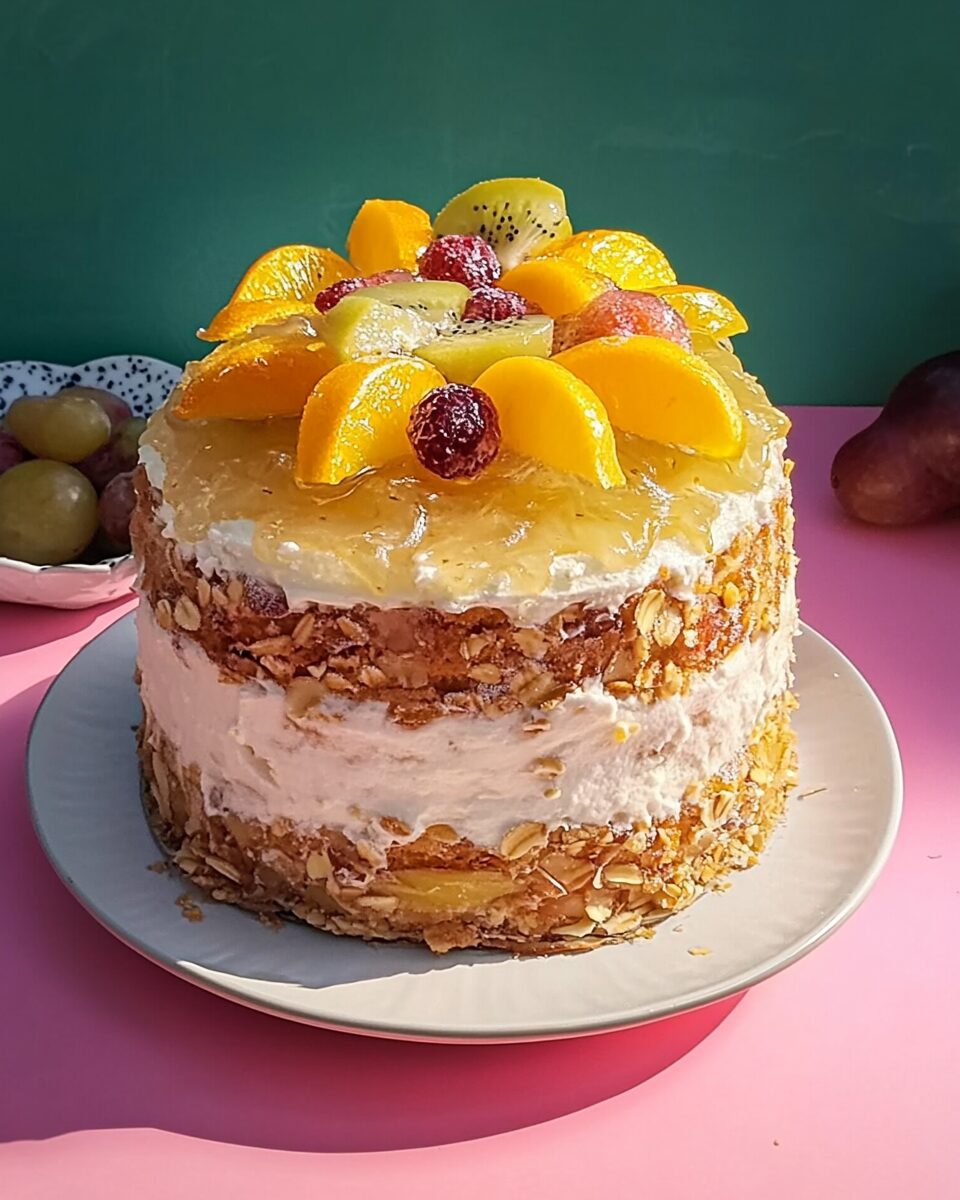Japanese Fruit Cake is a traditional Southern dessert that combines rich spices with a citrusy filling, resulting in a moist and flavorful treat. Despite its name, this cake doesn’t originate from Japan; rather, it’s a classic in Southern American baking, especially popular during the holiday season. The cake features layers infused with warm spices like cinnamon, nutmeg, and cloves, complemented by a sweet and tangy filling made from oranges, lemons, and coconut. This delightful combination offers a unique taste experience that’s both comforting and festive.
Full Recipe:
Ingredients
Cake:
- 2 cups raisins
- 2 cups flaked coconut
- 1 cup chopped pecans
- 3 cups all-purpose flour, divided
- 2 cups white sugar
- 1 cup butter
- 6 large egg yolks
- 4 teaspoons baking powder
- 2 teaspoons ground cinnamon
- 1 teaspoon ground nutmeg
- 1 teaspoon ground cloves
- 1 cup milk
- 6 large egg whites
Filling:
- 2 cups white sugar
- ¼ cup all-purpose flour
- 1 ½ cups water
- 2 oranges, peeled and seeded
- 2 lemons, peeled and seeded
- 2 cups flaked coconut
Directions
-
Prepare the Cake Layers:
- Preheat the oven to 350°F (175°C). Grease and flour four 9-inch round cake pans.
- In a medium bowl, toss together the raisins, coconut, and pecans with 1 cup of flour until well coated. Set aside.
- In a large bowl, cream together the sugar and butter using an electric mixer until light and fluffy. Beat in the egg yolks one at a time, mixing well after each addition.
- In a separate bowl, sift together the remaining 2 cups of flour, baking powder, cinnamon, nutmeg, and cloves.
- Add the flour mixture to the butter mixture in batches, alternating with milk, beginning and ending with the flour mixture. Beat briefly after each addition.
- Fold in the raisin mixture until evenly distributed.
- In a clean bowl, whip the egg whites to stiff peaks. Gently fold them into the batter until no streaks remain.
- Divide the batter evenly among the prepared cake pans.
-
Bake the Cake Layers:
- Bake in the preheated oven for about 30 minutes, or until a toothpick inserted into the center comes out clean.
- Allow the cakes to cool in the pans for 10 minutes before turning them out onto wire racks to cool completely.
-
Prepare the Filling:
- In a saucepan, combine the sugar and flour. Add water and stir over medium heat until the sugar is dissolved.
- Chop the oranges and lemons into small pieces and add them to the saucepan.
- Bring the mixture to a boil and cook until thickened, about 10 minutes.
- Stir in the coconut and set aside to cool.
-
Assemble the Cake:
- Place one cake layer on a serving plate and spread a portion of the filling over the top.
- Repeat with the remaining layers, ending with the filling on top.
Nutritional Facts
- Calories: 211 kcal
- Total Fat: 8g
- Saturated Fat: 5g
- Cholesterol: 36mg
- Sodium: 86mg
- Total Carbohydrates: 34g
- Dietary Fiber: 2g
- Total Sugars: 24g
- Protein: 3g
- Vitamin C: 7mg
- Calcium: 41mg
- Iron: 1mg
- Potassium: 132mg
The Origins of Japanese Fruit Cake
The history of Japanese Fruit Cake is somewhat mysterious, with no definitive explanation for its name. Unlike traditional fruitcakes that originate from Europe, this cake has strong roots in the Southern United States. It is believed to have been created in the late 19th or early 20th century when home bakers began experimenting with spice cakes and citrus fillings.
One theory suggests that the name “Japanese Fruit Cake” was inspired by the exotic appeal of the citrus fruits used in the filling. During that time, oranges and lemons were considered luxury items in many parts of the U.S., and their inclusion in desserts may have been associated with something foreign or exotic. Another possibility is that the cake was influenced by Japanese sponge cakes, which have a similarly soft and airy texture.
Regardless of its origins, the cake has remained a favorite in Southern baking traditions. Many families still use handwritten recipes passed down through generations, ensuring that the legacy of this unique dessert continues.
What Makes Japanese Fruit Cake Unique?
Japanese Fruit Cake is distinct from other fruitcakes in several ways:
- Soft and Moist Layers – Unlike traditional fruitcake, which is often dense and chewy, Japanese Fruit Cake has a light, fluffy texture.
- Spiced Cake Base – The cake layers are flavored with warm spices like cinnamon, nutmeg, and cloves, giving it a rich and cozy taste.
- Citrus Fruit Filling – Instead of candied or dried fruits, this cake uses fresh oranges, lemons, and coconut for a bright and tangy contrast.
- Minimal Use of Alcohol – Traditional fruitcakes often require alcohol for preservation, but Japanese Fruit Cake focuses on natural flavors.
- Perfect for Special Occasions – This cake is commonly made for Christmas, Thanksgiving, weddings, and family gatherings.
The Role of Citrus in Japanese Fruit Cake
One of the standout features of Japanese Fruit Cake is its citrus filling. Unlike the sugary, dense fillings found in some holiday cakes, the filling in this cake is made with fresh oranges and lemons, adding a tart and refreshing contrast to the spiced cake layers.
The natural acidity of citrus fruits helps balance the sweetness of the cake, preventing it from becoming overly rich. Oranges contribute a mild, sweet flavor, while lemons add a tangy kick. The addition of coconut enhances the texture and provides a slight tropical undertone, making each bite a burst of flavor.
This use of citrus is what sets Japanese Fruit Cake apart from many other fruit-based cakes. It provides a lighter, more refreshing taste while still maintaining the warmth and depth of traditional holiday spices.
Why Japanese Fruit Cake is a Holiday Favorite
Japanese Fruit Cake has long been associated with the holiday season. Its rich flavors, combined with its festive presentation, make it a perfect dessert for Christmas, Thanksgiving, and New Year’s celebrations. Some of the reasons why this cake remains a holiday staple include:
- Traditional Family Recipes – Many families have their own version of the recipe, passed down from previous generations.
- Seasonal Ingredients – The use of oranges and lemons, which are in peak season during winter, makes it an ideal holiday treat.
- Perfect for Sharing – The multi-layered structure makes it an impressive centerpiece for gatherings.
- Rich, Warm Flavors – The combination of spices, fruit, and coconut creates a comforting and nostalgic taste.
Variations of Japanese Fruit Cake
While the classic recipe remains the most popular, there are several variations of Japanese Fruit Cake that bakers have experimented with over the years:
- Nut-Free Version – Some recipes omit pecans or walnuts for those with nut allergies.
- Extra Spiced Cake – Adding more cinnamon, nutmeg, or cloves enhances the warm flavors of the cake.
- Chocolate Japanese Fruit Cake – A modern twist that incorporates cocoa powder into the cake layers for a richer taste.
- Gluten-Free Japanese Fruit Cake – Substituting almond flour or gluten-free baking flour makes it accessible to those with dietary restrictions.
- Dairy-Free Variation – Using plant-based milk and butter substitutes allows those with lactose intolerance to enjoy the cake.
Pairing Japanese Fruit Cake with Other Holiday Treats
Japanese Fruit Cake pairs well with a variety of holiday beverages and desserts. Some great pairings include:
- Hot Tea or Coffee – The warm spices in the cake complement the rich flavors of a hot drink.
- Eggnog – The creamy, spiced taste of eggnog enhances the festive feel of the cake.
- Whipped Cream or Ice Cream – A scoop of vanilla or coconut ice cream adds an extra layer of indulgence.
- Dark Chocolate – A small piece of dark chocolate on the side contrasts beautifully with the citrusy filling.
How to Store and Preserve Japanese Fruit Cake
To keep the cake fresh and flavorful, proper storage is essential:
- Refrigeration – The cake can be stored in the fridge for up to a week. Keeping it in an airtight container prevents it from drying out.
- Freezing – If you want to save some for later, wrap individual slices in plastic wrap and freeze them. The cake can be thawed at room temperature before serving.
- Room Temperature – If the cake will be consumed within two days, it can be kept at room temperature in a covered container.
Common Mistakes to Avoid When Making Japanese Fruit Cake
Even experienced bakers can make mistakes when preparing this cake. Here are some common pitfalls and how to avoid them:
- Overmixing the Batter – This can lead to a dense cake rather than a light, fluffy texture. Mix just until ingredients are combined.
- Using Too Much Liquid in the Filling – The citrus filling should be thick enough to hold between layers without making the cake soggy.
- Not Letting the Cake Cool Completely – Assembling the cake while it’s still warm can cause the layers to slide.
- Skipping the Flour Coating for Raisins and Nuts – Tossing these ingredients in flour prevents them from sinking to the bottom of the cake.
Conclusion
Japanese Fruit Cake is a delightful and nostalgic dessert that continues to be a holiday favorite in many Southern homes. Its combination of spiced cake layers and tangy citrus filling creates a perfect balance of flavors, making it a unique alternative to traditional fruitcake. With its rich history, beautiful presentation, and comforting taste, this cake is a must-try for anyone looking to add something special to their holiday dessert table. Whether you follow a family recipe or try a new variation, Japanese Fruit Cake is sure to impress both guests and family members alike.






